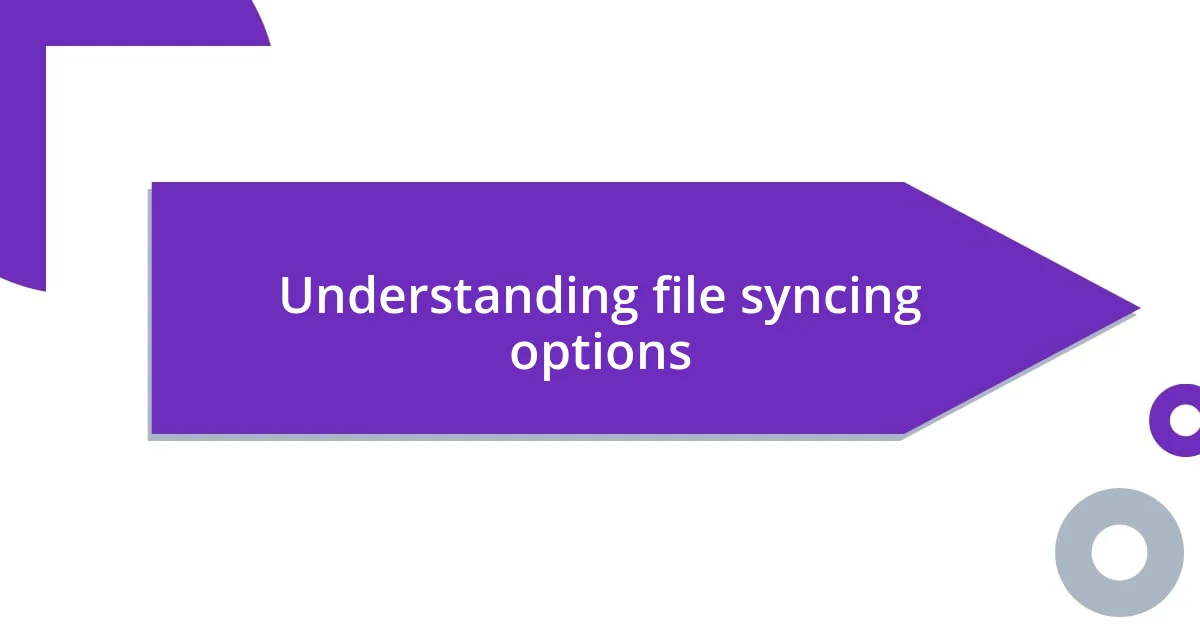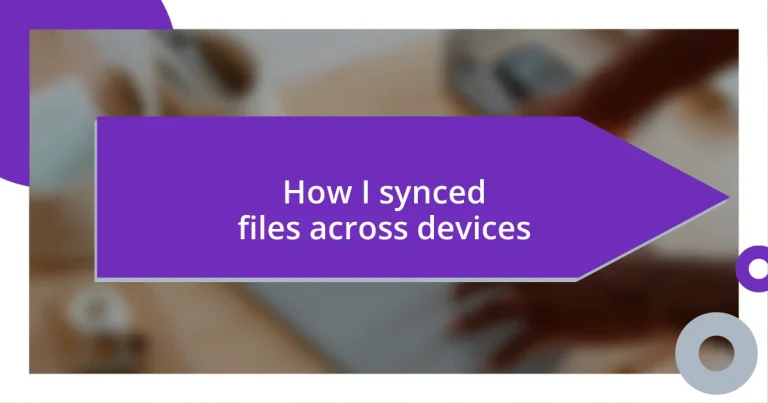Key takeaways:
- Evaluate file syncing options based on your needs, prioritizing accessibility, control, and data security.
- Choose a reliable cloud service considering factors like storage capacity, pricing, user interface, and security features to ensure seamless access and collaboration.
- Implement best practices for file management, including strong passwords, two-factor authentication, and regular backups, to enhance security and prevent data loss.

Understanding file syncing options
When it comes to file syncing options, there’s a world of choices out there. I remember the first time I faced the dilemma of which platform to choose; I felt overwhelmed by the options but excited about the possibilities. Each solution, whether it’s cloud-based services like Google Drive or Dropbox, or local syncing tools like Resilio Sync, presents unique benefits depending on how and where you work.
It’s crucial to consider what you truly need. For instance, do you prioritize accessibility across multiple devices, or is it more important for you to have complete control over your files? Personally, after dealing with loss of data on a cloud service due to an unexpected outage, I found that having dual backup options gave me peace of mind. It was a bit of a wake-up call about the fragility of relying solely on one method.
Don’t underestimate the power of automated syncing features, either! I’ve found that when I set certain folders to sync automatically, it frees up so much mental bandwidth, allowing me to focus on more creative tasks. Have you ever considered how much time you could save by automating these processes? It’s those small conveniences that often prove invaluable in our hectic lives.

Choosing the right cloud service
Choosing the right cloud service can feel like a daunting task, especially with so many options available. I vividly recall my first experience with cloud storage—I chose a service based on trendy recommendations, only to realize it didn’t meet my needs when I couldn’t access my files offline during a trip. It drove home the importance of making an informed choice.
Here are some factors you should keep in mind:
- Storage Capacity: Evaluate how much space you’ll need for your files and whether the service offers sufficient storage without breaking the bank.
- Pricing Plans: Consider if the pricing structure fits your budget; some services charge monthly while others offer annual subscriptions for savings.
- User Interface: Look for an intuitive interface that will make navigation a breeze, especially if you’re not tech-savvy.
- Device Compatibility: Ensure the service is compatible with all your devices—this includes your smartphone, tablet, and computer, regardless of the operating system.
- Security Features: Prioritize services that offer strong encryption and privacy settings; I’ve always felt more at ease knowing my data is secured.
Once I switched to a more reliable cloud service that provided seamless access and robust security features, it felt like a weight lifted off my shoulders. I could share files easily with colleagues without worrying about potential data breaches—and that confidence has made all the difference in my day-to-day work.

Setting up synchronization on devices
Setting up synchronization can be a straightforward process, but it often requires careful attention to detail. I remember the first time I synced my devices; it felt like solving a puzzle where each piece was essential. Once I identified the right settings, everything clicked into place. For example, configuring a service like Dropbox was as simple as downloading the app, signing in, and selecting my sync preferences. I was ecstatic to see my files accessible on my phone right after making changes on my laptop!
Be mindful of any specific settings that might impact your sync experience. Have you ever noticed how some apps allow you to exclude certain folders from syncing? I learned this the hard way when I accidentally stored a massive video project in my sync folder, which caused my storage to max out. It’s those little tweaks—like choosing specific folders to sync—that can make a huge difference in your workflow. Managing this effectively ensures that I’m not just syncing files, but also optimizing my device’s performance.
Another essential step is to check the connectivity between your devices. As I was syncing my work computer with my tablet, I encountered some hiccups due to a weak Wi-Fi signal. It was frustrating, but it taught me to ensure that my devices are consistently connected to a strong network during the sync process. Trust me; those moments of realization can be a worthwhile lesson in keeping my files up to date without unnecessary interruptions.
| Factors to Consider | Personal Experience |
|---|---|
| Storage Capacity | Wished I had checked the capacity before syncing my large media files! |
| Pricing Plans | Found an annual plan that saved me money in the long run. |
| Device Compatibility | Regretted it when my old tablet couldn’t support the latest update! |
| Security Features | Feeling secure has allowed me to share files without trepidation. |
| Sync Preferences | Customizing what syncs has made my device run smoother. |

Managing files effectively across platforms
Managing files effectively across platforms isn’t just about syncing; it’s also about smart organization. I learned this lesson the hard way after finding myself frantically searching for a crucial document amidst a chaotic file system. It struck me that labeling and categorizing files logically can save time and reduce frustration. Have you ever spent precious minutes hunting for a file? I have, and that moment pushed me to create a better folder structure that worked across all my devices, so I could find what I needed at a moment’s notice.
Another key aspect is version control. There was a time I accidentally overwrote an important presentation and faced a mini-crisis. Thankfully, my cloud service tracked changes, allowing me to restore an earlier version with just a few clicks. The relief I felt was immense. I realized how vital it is to choose a platform that offers this feature—it ensures that I can easily recover from mishaps and keep working without major setbacks. An effective file management strategy includes understanding how to retrieve previous versions of your documents.
Finally, consider the user permissions for shared files. I once shared a folder with a colleague, assuming they had editing rights, only to discover they could only view it. This oversight led to delays in a project we were collaborating on. That experience highlighted for me the importance of clear permissions—setting them correctly can streamline workflows and foster better teamwork. How are you managing permissions in your shared drives? It’s a small detail that holds great significance, especially when efficiency is at stake.

Troubleshooting common syncing issues
Syncing issues can be incredibly frustrating, but I’ve found that a few common troubleshooting steps can often resolve them swiftly. For example, I once encountered a syncing delay with my phone and laptop, and it turned out that I needed to refresh the app on both devices. Sometimes we overlook the simplest solutions, don’t we? A quick restart can work wonders.
I also recall a time when my files seemed to disappear from one of my devices. After panicking, I discovered that my sync settings had reverted to their defaults. It’s easy to overlook settings, especially if you’re not regularly checking them. If you find yourself in a similar situation, take a moment to review those settings—they can be the key to restoring your peace of mind.
Lastly, let’s not forget about notifications! There have been occasions when I missed out on important updates because they were muted. I learned to enable notifications for my syncing app, ensuring I’m alerted to any issues immediately. Have you ever had a deadline loom over you, only to find your files haven’t synced? It’s a wake-up call for staying proactive about keeping tabs on your syncing status.

Best practices for file security
When it comes to file security, one of the best practices I’ve embraced is using strong passwords. I vividly remember a time when I received an alarming notification stating that my cloud account had irregular login attempts. It shook me! That’s when I realized a complex password is not just a recommendation—it’s essential. I now use a mix of upper and lowercase letters, numbers, and symbols, making it far less predictable. Have you checked the strength of your passwords lately?
Another important tip is enabling two-factor authentication (2FA). After setting it up on my accounts, I felt a wave of relief; it adds another layer of protection that I didn’t know I needed. I once experienced a brief scare when a friend’s account was hacked simply because they didn’t have 2FA active. That incident was a real eye-opener for me, illustrating how this simple step can safeguard sensitive information. Are you taking that extra step to protect your data?
Lastly, I highly recommend regularly backing up your files. I’ve learned this lesson after losing a report right before a major presentation—a nightmare scenario, to say the least! Since then, I’ve made it a habit to back up everything weekly and keep multiple copies in different locations. This practice not only provides peace of mind, but it also offers a safety net during unexpected crises. How often do you back up your essential files? Taking a proactive approach can save you from future headaches.

Tips for optimizing syncing speed
To optimize syncing speed, I’ve found that choosing the right network connection can make all the difference. For instance, I once tried syncing files over a public Wi-Fi network, and it felt like watching paint dry. It wasn’t until I switched to my home network that things sped up dramatically. Have you ever wondered how much your connection type might be slowing you down?
Another tip is to prioritize the files you need most. The first time I attempted a large sync, I was left waiting forever for my entire library of photos to upload. I realized that only syncing essential files at first drastically reduced the wait time. Now, I always consider what absolutely needs to be synced immediately and save the rest for later. Have you thought about which files are non-negotiable for your workflow?
Lastly, regularly updating your syncing applications is crucial. I remember putting off an app update and, to my surprise, experienced lag that made syncing excruciatingly slow. Once I updated, however, I noticed a significant boost in speeds. It’s a simple step that I often overlook, but now I make it a habit to check for updates routinely. Are you maximizing the potential of your tools by keeping them current?














